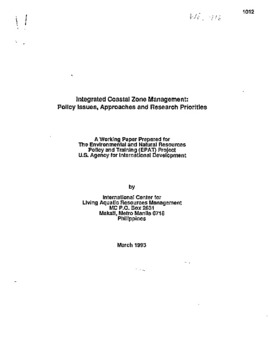Integrated coastal zone management: policy issues, approaches and research priorities: a working paper prepared for the Environmental and Natural Resources Policy and Training (EPAT) Project, US agency for International Development

Citation
Pomeroy, R.S.; Chua, T.E. (1993). Integrated coastal zone management: policy issues, approaches and research priorities: a working paper prepared for the Environmental and Natural Resources Policy and Training (EPAT) Project, US agency for International Development. ICLARM. Makati, Philippines. 38 p.
Over the last several decades, Malaysia has experienced rapid industrial growth and urbanization, characterized by high levels of resource exploitation. Much of this development has occurred within the coastal,Zone. Malaysia is a coastal state, with a 48,000-km coastline. Key coastal ecosystems include mangroves, sandy beaches, coral reefs, estuaries and mudflats. About 36 percent of the country's 15 million population live in the coastal zone. Some 110,000 fishermen are directly dependent on the coastal fisheries resources. Fisheries supply approximately 75 percent of the protein requirement of the country's population. Mangrove forest in Malaysia covers about 600,000 ha. The coastal zone is the site for important ports and harbors and the coastal waters are the main means of transportation in many parts of Malaysia. With the promotion of tourism, the coastal zone is also the center of recreational activities. Much of the terrestrial area in the coastal zone is in agriculture including oil palm, rubber, coconut, aquaculture, and fruits.
Permalink
Date Available
Type
Publisher
Countries
Copyright
CC BY 4.0
Research Themes
Topics
Language